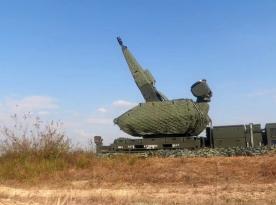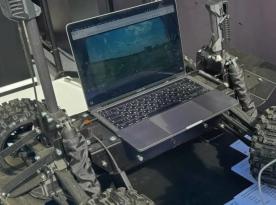Reports on social networks claim that during the operation in the Kursk Region of russia, the Ukrainian Defense Forces used an M712 Copperhead — a projectile with in 155 mm caliber, guided by a laser beam — to inflict losses on the russian army.
What's so notable about this situation is that the M712 Copperhead was created and mass-produced in the USA back in the 1970s, in fact, it is a representative of the very first generation of guided projectiles, so the appearance of such ammunition on the battlefield in the modern day was unexpected, to put it mildly.
Read more: The Ukrainian Air Force Uses Unusual Bombs Equipped with AASM Hammer Kits (Photo)
Photos allegedly showing the impact of the archaic shell on a communications tower were shared by In Factum, a war news community on Telegram. The author says it happened east of Sudzha, a russian city occupied by Ukrainian forces. A total of three projectiles were spent on this target, fired from an M777 howitzer.

The M712 Copperhead has a range of 3 to 16 kilometers, a soldier in the field has to designate the target with a laser pointer to achieve the precision-guided effect. The weight of the projectile is 62.4 kilograms, or almost 138 pounds.

Copperhead entered mass production in 1978, and is no longer produced. For the first time, this type of ammunition was used by the U.S. Army during Operation Desert Storm, with a total of 90 fired.
Open sources state that as of 1995, the U.S. Armed Forces had up to 20,000 M712 Copperhead guided shells in storage. There's also information that in 2017, Lebanese government forces received "several hundred" M712 Copperhead projectiles from the U.S. to counter ISIS units.

Defense Express emphasizes that it's currently unknown where the Ukrainian Defense Forces could have obtained the M712 Copperhead from or how many. Nonetheless, the very option of using these guided munitions to strike down russian forces offers its own utility, especially considering russia's active use of electronic warfare systems, hindering with GPS-guided shells yet useless against laser-beam navigation.
Earlier, we extensively covered the use of Krasnopol precision-guided projectiles by the russian army and the methods Ukrainians employ to counter them. This russian-made guided shell is believed to be a result of the USSR simply borrowing technological solutions from the American M712 Copperhead for its own product, officially adopted by the Soviet military in 1986.
Read more: What Strategies Do Ukrainian Forces Employ in Response to russian Scalpel and Krasnopol Systems














